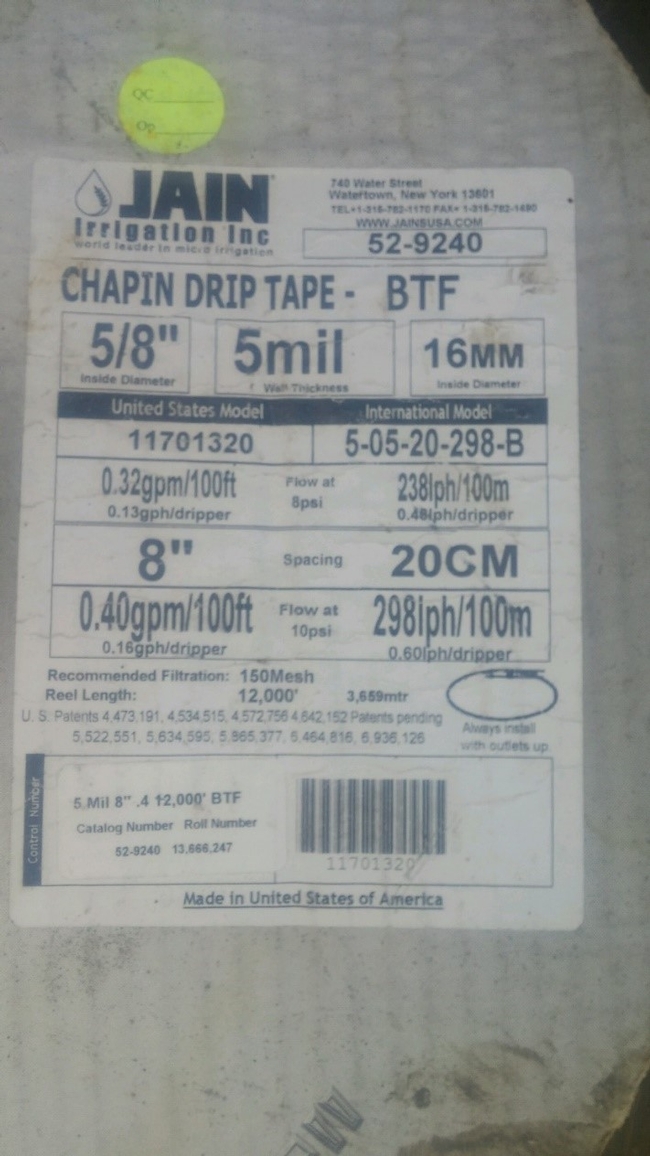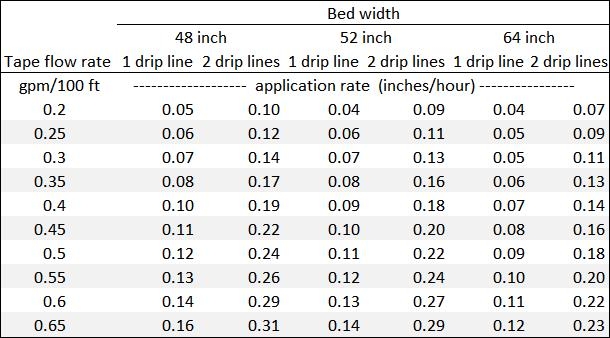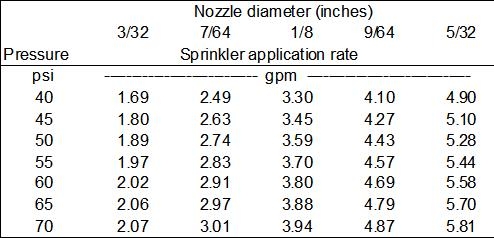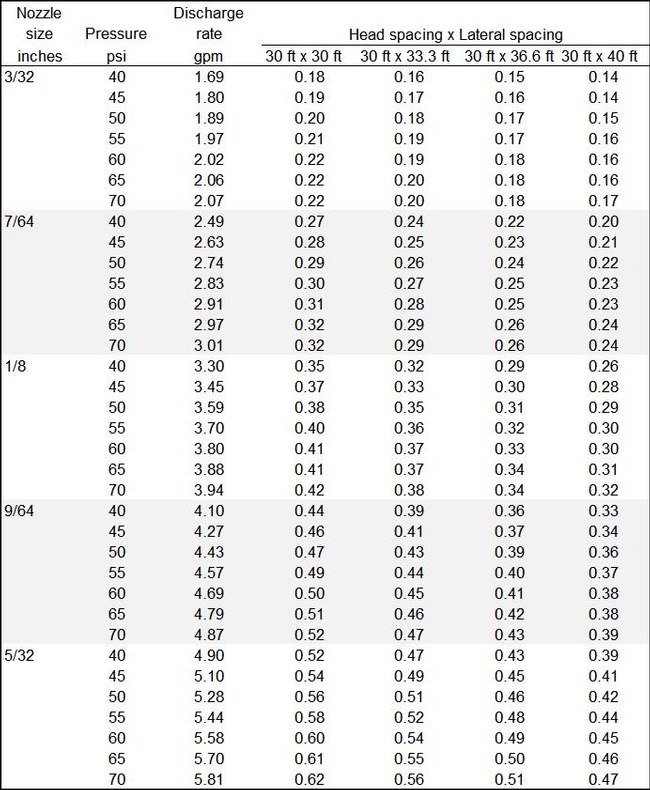How to estimate the application rate of drip and sprinkler systems
Determining how long to run your irrigation system can be challenging because typical recommendations on how much water to apply are expressed in units of inches (or feet) of water depth. Knowing the application rate of your irrigation system will allow you to convert these recommendations into the time (hours) to operate the irrigation system.
The application rate is the depth of water that the irrigation system applies during a period of time, and is typically expressed in units of inches per hour (in/hr). An application rate of 0.27 in/hr means that when the system is operated for one hour it will apply 0.27 inches of water to the field; if it is operated 45 minutes, 0.2 inches (0.27 in/hr × 45 min ÷ 60 min/hr) are applied and so on.
Note that the application rate is independent of the number of acres irrigated. In other words, an irrigation system would have the same application rate on a one-acre or a five-acre block. For raised bed crops such as vegetables and strawberries, the application rate includes the area of both the furrows and the bed tops.
Determining the application rate of drip systems
The variables determining the application rate of drip systems are: 1. bed width, 2. number of drip lines per bed, and 3. flowrate of the drip tape. The flow rate of the tape (also referred to as the discharge rate) corresponds to a specific pressure, usually 8 or 10 pounds per square inch (psi). The flow rate of the drip tape is usually specified on the label of the tape roll (Fig. 1) and is often expressed in units of gallons per minute per one hundred feet of tape (gpm/100 ft).
Figure 1. Examples of a drip tape label with flow (discharge) rate information.
Some tape manufacturers provide the discharge rate of the emitters and the emitter spacing rather than the flow (discharge) rate of the tape. The discharge rate of the emitters is usually expressed in units of gallons per hour (gph). To calculate the tape flow rate from the emitter discharge rate, use the following equation:
Tape discharge rate (gpm/100 ft) = Emitter discharge rate (gph) × 20 ÷ emitter spacing (inches) [1]
Example (from Fig. 1): emitter discharge rate = 0.16 gph; emitter spacing= 8 inches
Tape discharge rate (gpm/100 ft) = 0.16 gph × 20 ÷ 8 inches = 0.40 gpm/100 ft
The application rate of a drip system can be determined from the tape flow rate (gpm/100 ft), bed width (inches), and number of drip lines using the following equation:
Application rate (inches/hour) = tape flow rate (gpm/100 ft) × number of tapes × 11.55 ÷ bed width (inches) [2]
Example: tape flow rate = 0.45 gpm/100 ft; bed width = 48 inches; 2 drip lines per bed
Application rate = 0.45 gpm/100 ft × 2 drip lines × 11.55 ÷ 48 inches = 0.22 inches per hour
Table 1 also summarizes application rates of some common drip system configurations for strawberry. The application rate of the drip system can be estimated by finding the row with the flow rate that is closest to the tape that you use, and then reading the application rate under the bed and drip line configuration used at your farm.
Table 1. Application rate (in/hr) of drip systems for common drip tape flow rates and bed widths in strawberry.
Determining the application rate of solid-set and hand-move sprinkler systems
To estimate the application rate in sprinkler systems (aluminum hand-move pipes) one needs to know the spacing of the lateral lines, the sprinkler nozzle size and pressure at which the system is operated. For hand-move sprinklers, the distance that the sprinkler line is moved between irrigation sets is the lateral line spacing. Pressure can be measured at the sprinkler nozzle using a with a pitot tube fitted with a pressure gauge. Alternatively, a gauge or Schrader valve can be added to a riser so that the pressure can be measured on the lateral line. Discharge rate of sprinkler heads will increase with higher pressures and larger nozzle sizes. Most manufacturers provide data on discharge rate for each sprinkler head model. Table 2 shows the range of discharge rates for the Rainbird 20JH model.
Table 2. Discharge rates of Rainbird 20 JH sprinkler heads at varying nozzle sizes and pressures.
From the discharge rate, lateral pipe spacing, and discharge rate, the application rate for a sprinkler system can be estimated using the equation:
Sprinkler application rate (inches/hr) = discharge rate (gpm) × 96.3 ÷ [lateral spacing (ft) × head spacing (ft) [3]
Example: Sprinkler head = Rainbird 20JH with 7/64 inch nozzle operated at 45 psi; lateral spacing = 40 ft; head spacing = 30 ft.
From Table 2 the discharge rate of the sprinkler head = 2.63 gpm.
Sprinkler application rate (inches/hr) = 2.63 gpm × 96.3÷[30 ft ×40 ft] = 0.21 inches/hr
Alternatively, Table 3 can be used to estimate the application rate of an irrigation system using the Rainbird 20JH sprinkler heads.
Table 3. Application rates for sprinkler systems using Rainbird 20 JH heads at varying pressures, nozzle sizes, and lateral and head spacings.
Using the application rate to determine how long to irrigate
The application rate can be used to determine how long to irrigate a crop from estimates of crop water use. For an average year in the Pajaro Valley, a strawberry crop needs one inch of water during a typical week in August and about 28 inches for an entire crop cycle. A grower with an application rate of 0.22 inches/hour will need to irrigate four and a half hours (1 inch ÷ 0.22 in/hr = 4.5 hr) during a week in August and a total of 127 hours (28 in ÷ 0.22 in/hr = 127 hr) during the entire season.
Summary
Accurately estimating the application rate of an irrigation system requires precise knowledge of the discharge rate of the drip tape or sprinkler nozzle. Over time, nozzles become worn and drip emitters clog, or the pressure of the system may not be operated at the specifications of the manufacturer. The best way to accurately know the application rate is to directly measure it in the field. For direct measurements of the application rate, schedule an on-site irrigation evaluation with the RCD of Santa Cruz County at: 831-464-2950, info@rcdsantacruz.org.




THE INFORMATION IS VERY INTERESTING AND ABOVE ALL, ACCURATE.
Posted by ANTONIO CÁRDENAS FLORES on July 13, 2021 at 7:45 AM